Can't get any bigger or stronger? You may be neglecting some important exercises.
This will be a series of articles explaining the most common muscles that we often neglect. In our strive to be the biggest and best, we often fail to look at the little things that will help us get even bigger and better. I know a lot of articles are not written about this, so therefore most guys are in the dark. Most of the common questions of new trainees are: "How do I work the inner part of my chest? How do I get my chest bigger? How do I get to press more weight?" Why? Because they were never taught anything else.
Have you ever reached an area in your benching that you seemed to stick at? Or your failure point was too quick? Most of the time it is because of these overlooked areas. How many guys actually train their stabilizer muscles on purpose? How many trainees actually know that this is a good thing to do? I would guess that very few if any, realize this. Most trainees are more concerned with" getting big" instead of getting functional. There are some problems associated with only "getting big." Let's take a look at one of the most commonly overlooked areas, The Rotator Cuff.
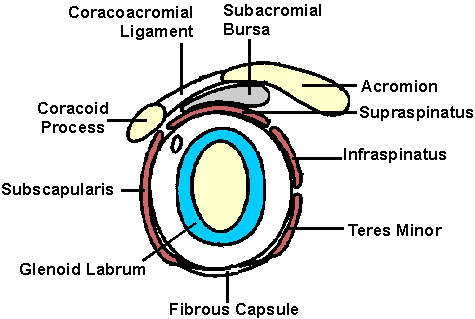
The rotator cuff (or Infraspinatus), is basically involved in a major way when it comes to benching. Have you ever noticed your shoulder area seems to hurt at times before you come to failure? Most of the time this is due to a weak rotator. This could also be said for a lot of other exercises too. This is due to the fact that the rotator really works hard during a lot of different movements you make. Now the rotator cuff is a part of the shoulder.
It is a group of tendons that attach together and surround the top, the rear and the front of the shoulder. It actually surrounds it like a cuff on a shirt sleeve will surround your wrist. These tendons are individually connected to short muscles that originate from the scapula (shoulder blades). When these muscles contract they pull on the rotator cuff tendon, causing the shoulder to rotate. This pull causes the shoulder to rotate upward, inward or downward, this is why it's called the rotator cuff.
While doing a bench you may experience some rotator or shoulder pain, during part of the execution. This could be due to excessive stretching or weak muscles in this area. Some trainees will complain of massive pain for the next week or more, this could be due to an impingement. There are a few reasons for this impingement, one that could be a normal problem overlooked. Due to the narrow space here, some trainees may have the tendon and the adherent lubricating tissue (bursa), pinched when the arm is raised in a certain position.
Usually forward movement is the main cause of this. Sounds a little like a bench press. So as you can see not working this area could dramatically decrease the bench and may cause some problems in this area. Now as the trainee continues to use this area (after the soreness has started, which would be common due to working other body parts), the tendons become inflamed and sore. But the trainee still works them, not realizing the possible problems he is causing.
So why is this important to me? Well let's look at a possibility. When the rotator tendons are inflamed as well as the surrounding tissue, the tendon could possibly start to break down and cause more damage at this area. It could actually all together fail and break away from it's attachments. In younger guys who do weight training, this is more common than you would guess to think. Due to the repetitive throwing and benching, this has a good possibility of happening. The constant stretching and lifting of this area could very well constitute a tear. Most of the time this would be due to a joint imbalance. But most often is caused by a weakness in the muscle itself.
OK. Maybe I have your attention now. You're probably asking, "So how do I avoid this problem?" What type of exercises do I do to help strengthen this area?" Good questions! Let's look at a few routines to help. Everyone seems to have their own way to do these exercises, so we will look at a few variations.
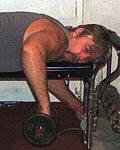
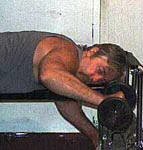
Start by lying on your stomach on a bench. Extend your left arm out at the same level as your shoulder. Keep a 90-degree bend in your elbow and have your hand down. Keeping the elbow bent, slowly raise the hand until it is level with your shoulder. Keep the palm facing downward at all times. Now lower the hand and repeat. Do this until fatigue sets in. Then repeat this with the other arm.
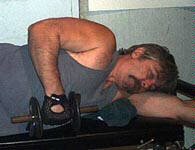
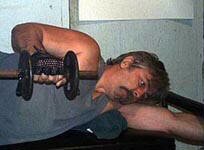
Lay on your side with a rolled-up towel or jacket under your armpit. Stretch your one arm that you are laying on, above your head. Keep the other arm at your side with your elbow bent at 90 degrees and the forearm should be resting against your chest. This is the arm you will be working. Keep the palm facing downward. Raise the weight up keeping the bend in the elbow and the upper part of the arm tight to your side. This would be called rolling the arm upward. Bring the forearm level with the shoulder, then slowly lower the arm to the starting position. Do this until fatigued then continue with the other arm rolling to your other side. If this is confusing then just make believe you are doing a backhand swing in tennis.
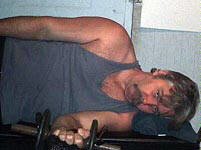
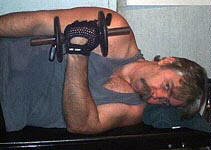
Lay on your side again but this time put the top arm at your side, flat. Now bend your lower arm (the arm you will be lying on top of) at the elbow to a 90-degree angle. Keep the forearm resting on the top of the bench.
Now raise the forearm up to the opposite shoulder (rolling the arm), keeping the upper part of the arm on the bench at all times. Keep the palm facing upward through out this. Bring the forearm into your chest. This would be similar to a forehand swing in tennis. Then slowly lower the arm to the starting position. Do this until fatigue sets in. Then turn and do the other side.
There is a few variations of these exercises that we will also use.
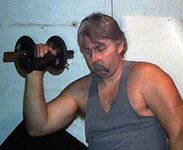
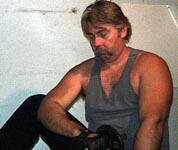
Sit on the bench or a chair, whatever is available to you. Put your one leg up, you will be sitting with one leg up on the bench and the other on the ground.The leg on the bench is bent at a 90-degree angle. Now extend one arm and allow it to rest against your groin area. Keeping a 90 degree in your elbow as doing this, bring you arm up to level with your shoulder. Keep the elbow in the groin at all times. Once it is level then slowly lower back to the starting position. Go to fatigue using a slow pace, with this. Once done with the one side, repeat on the other side.
Sitting in the same position place one arms elbow on the outer part of your quad. Now throughout this keep the elbow bent at all times at 90 degrees. Slowly lower the arm that is resting against the quad in a rotation fashion down to the outside of the leg. Keep the elbow against the leg at all times during this. Go as far as comfortable. Once this is reached slowly raise it and repeat. Do this slowly and go until fatigue is reached. Do not force the speed. Once done with one side, do the other.
I would train the rotator once each week with the arms. Use enough weight to fail at 8-12 reps. Use 2-3 sets. I use 3 of the exercises continuously. Once I have used them for 4 weeks then I switch up.
Try this for a few weeks and see if you get better at certain things such as benching and swimming or even tennis. Of course if a pain does come, stop what you are doing and see a qualified physician. This way you can determine what the problem is. Once an impingement comes there are only a few alternatives and one of them is rest. So don't be afraid to take some time off and get rest. Usually this will be the best medicine allowing you to come back even stronger.
I hope this article has enlightened some of you and possibly answered most of your questions on this subject. But remember it is always the little things that will cause problem and if you take care of them first, the rest is easy. The next one in the series, we will talk about legs and the problem associated with them and the muscles that get in the way. We will also talk about possible cures for them. Until then train hard and learn all you can ... to be the best you can.
